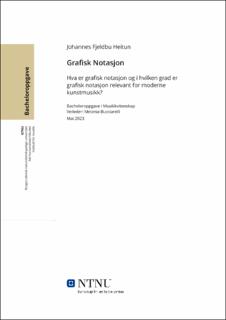| dc.contributor.advisor | Melania Bucciarelli | |
| dc.contributor.author | Heitun, Johannes Fjeldbu | |
| dc.date.accessioned | 2023-07-06T17:19:32Z | |
| dc.date.available | 2023-07-06T17:19:32Z | |
| dc.date.issued | 2023 | |
| dc.identifier | no.ntnu:inspera:145107873:34525103 | |
| dc.identifier.uri | https://hdl.handle.net/11250/3076881 | |
| dc.description.abstract | Bruken av grafiske notasjonsformer i vestlig kunstmusikk hadde sin oppblomstring i løpet av den andre halvdelen av det 20. århundre. Gjennom innovative komponister som John Cage, Karlheinz Stockhausen, og Earle Brown ble grafiske elementer implementert i komposisjon for å representere nye lyder og teknikker som ikke lenger kunne representeres gjennom konvensjonell vestlig notasjon (McKenna, 2011, s. 3). I hvilken grad grafiske elementer skulle anvendes alene eller i kombinasjon med konvensjonell vestlig notasjon var omdiskutert og ble derfor anvendt i svært ulike former
(Bröndum, 2018, s. 641). Disse formene varierte fra hverandre i hvilken rolle ubestemthet skulle ha i den komposisjonelle prosessen, altså hvilke aspekter som skulle være under utøverens interprative kontroll (Bröndum, 2018, s. 640). Dagens komponister innenfor kunstmusikk har tilgang på teknologi som ikke var tilgjengelig for komponister som John Cage, Earle Brown, Karlheinz Stockhausen, m.m.. Eksempelvis kan man i dag ta i bruk notasjonsprogram som Sibelius og Dorico i komposisjonsprosessen, eller bruke animasjonsprogram for å animere grafisk notasjon gjennom applikasjoner som kan lastes ned på nettbrett eller smarttelefoner. Denne oppgaven tar for seg utviklingen av grafiske notasjonsformer som oppstod i løpet av 1900-tallet og forsøker å gi en omfattende definisjon på grafisk notasjon. I tillegg forsøker oppgaven å svare på i hvilken grad grafiske notasjonsformer er relevant for vår tids kunstmusikk, med tanke på utviklingen innenfor aspekter som animasjonsteknologi og notasjonsprogrammer. | |
| dc.description.abstract | The use of graphical forms of notation in western art music arised in the second part of the twentieth century. Through innovation and creativity, composers such as John Cage, Karlheinz Stockhausen, and Earle Brown implemented graphic elements as a part of the compositional practice. The use of graphic elements gave composers the tools to represent new musical sounds, techniques, and ideas, which no longer could be represented through conventional western notation (McKenna, 2011, s. 3). To which degree graphical elements were to be used in isolation or in combination with conventional western notation was disputed among composers, and it resulted in a wide array of approaches to graphical notation (Bröndum, 2018, s. 641). These approaches were distinguished by which part indeterminacy would play in the compositional process. Indeterminacy is a compositional process in which some or all aspects of the piece is in the interpretative control of the performer, rather than the composer (Bröndum, 2018, s.640). Composers in modern art music have access to advancements in technology which wasn’t accessible to the composers of the 1950s avant-garde. These advancements are everything spanning from notation software such as Sibelius and Dorico, and animation software which allow the use of animation of graphical scores through smart phones or tablets. This thesis summarizes the development of the graphical notation practices of the twentieth century and attempts to give insight to what graphical notation is and could be. In addition the thesis discusses whether or not uses of graphical notation is relevant for modern art music practices, with emphasis on notation- and animation software. | |
| dc.language | nob | |
| dc.publisher | NTNU | |
| dc.title | Grafisk notasjon. Hva er grafisk notasjon og i hvilken grad er grafisk notasjon relevant for moderne kunstmusikk? | |
| dc.type | Bachelor thesis | |
